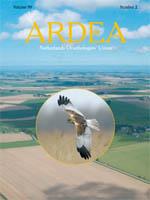We describe an observation of Griffon Vultures Gyps fulvus killing and eating a conspecific in Álava, northern Spain. We put this observation in the context of previous reports of cannibalistic behaviour in vultures. The reduction of livestock carcasses available to scavengers in the wild, a result of the carcass removal policy adopted by EU countries after the bovine spongiform encephalopathy (BSE) outbreak, could have contributed to this behaviour.
In the morning of 19 January 2007, we observed about 60 Eurasian Griffon Vultures Gyps fulvus feeding on a sheep carcass in Bergüenda in the province of Álava, northern Spain (42°46′16″ N; 3°03′16″W), less than 4 km from cliffs occupied by 284–334 breeding pairs (Hontza, pers. comm.). These vultures are part of one of the largest and densest populations in Europe (Sanz-Zuasti et al. 2004). The carcass was located on a steep slope (about 15%) in a patchy agricultural landscape with small Gall Oak Quercus faginea forests.
During the fights that occurred around the carcass, some rocks slid down the slope. This scared the vultures and all of them moved away except one that became trapped under one of the falling rocks. This rock pinned the bird down next to the carcass by the primaries of its right wing (Fig. 1). Within a minute, the other vultures returned and started eating the sheep carcass again. At that point, the trapped vulture was still alive, shaking its head and the non-trapped wing whilst trying to escape. Suddenly, some vultures began pecking the trapped individual, until the vulture was killed and finally partially eaten by its conspecifics.
This is the first documented report of killing and cannibalistic behaviour in Griffon Vultures in Spain that we are aware of (Donázar 1993). Camiña & Palomo (2003) reported two vultures feeding on the carcass of a conspecific, but the bird was already dead when feeding commenced. Mundy et al. (1992) recorded cannibalism in African White-backed Vultures Pseudogyps africanus, and referred to an observation by M. Jarvis and his colleagues on cannibalism in Cape Vultures Gyps coprotheres, but no details were provided to indicate if the birds had been killed by conspecifics or not. Margalida et al. (2004) recorded cannibalism in a Bearded Vulture Gypaetus barbatus nest. Kornan & Nacek (2011) recorded parental infanticide followed by cannibalism in Golden Eagles Aquila chrysaetos. Cannibalism linked with natural deaths of nestlings has also been documented in other raptor species, among others American Kestrel Falco sparverius (Bortolotti et al. 1991), Booted Eagle Aquila pennata (Dios 2003) and Bald Eagle Haliaeetus leucocephalus (Markham & Watts 2007).
Figure 1.
Leftovers of the carcasses of a Griffon Vulture and a sheep eaten by vultures. The rock on the left trapped the vulture's wing (photograph by F. Martinez de Lecea).

The outbreak of bovine spongiform encephalopathy (BSE), and the policy consequently adopted by EU countries (Regulation CE 1774/2002), resulted in the reduction of livestock carcasses in the wild (Donázar et al. 2009a, Margalida et al. 2010). The link between our anecdotal observation and the EU policy could not be assessed properly since cannibalistic behaviour might also occur in populations with high carcass availability (Camiña & Palomo 2003). Nevertheless, the reduction in carcass availability has resulted in impoverished reproduction, an increase in juvenile mortality, a higher incidence of conflicts with livestock (Donázar et al. 2009b, Margalida & Campion 2009), and probably behavioural changes (Zuberogoitia et al. 2010). Thus, food reduction may have increased intraspecific competition, and hence aggressiveness, leading to the killing and consuming of a Eurasian Griffon Vulture by conspecifics.
References
Appendices
Samenvatting
Na de uitbraak van de gekkekoeienziekte (BSE) zijn binnen de Europese Unie de regels aangescherpt voor de wijze waarop dode dieren moeten worden afgevoerd. In Spanje had dit grote gevolgen voor gieren, omdat er veel minder kadavers in de open lucht werden gedumpt dan voorheen. De verminderde beschikbaarheid van karkassen resulteerde bij Vale Gieren Gyps fulvus in een lagere reproductie en een hogere sterfte onder juveniele vogels. Bovendien werden er meer conflicten gemeld tussen gieren en vee, terwijl mogelijk ook het gierengedrag is gewijzigd. In dit licht bezien is de waarneming van een Vale Gier die door soortgenoten werd gedood relevant. Het betrof een vogel die met een vleugel klem kwam te zitten nadat onderling gekrakeel van 60 Vale Gieren bij het karkas van een schaap diverse rotsblokken naar beneden had doen tuimelen. Binnen een minuut na het ongeluk waren de geschrokken gieren terug bij het schaap, waarop ze plotseling op de beklemde, spartelende soortgenoot gingen pikken tot de dood erop volgde. De gedode gier werd vervolgens deels opgegeten. Is dit geval van kannibalisme een uitzondering of heeft het te maken met de sterke reductie van voedselaanbod en — dientengevolge — een hogere onderlinge agressiviteit? (RGB)





